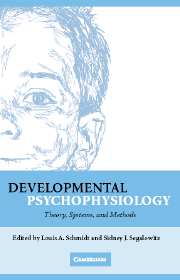Book contents
- Frontmatter
- Contents
- Foreword by Stephen W. Porges
- Preface
- Acknowledgments
- Contributors
- 1 Capturing the Dynamic Endophenotype: A Developmental Psychophysiological Manifesto
- SECTION ONE CENTRAL SYSTEM: THEORY, METHODS, AND MEASURES
- SECTION TWO AUTONOMIC AND PERIPHERAL SYSTEMS: THEORY, METHODS, AND MEASURES
- SECTION THREE NEUROENDOCRINE SYSTEM: THEORY, METHODS, AND MEASURES
- SECTION FOUR DATA ACQUISITION, REDUCTION, ANALYSIS, AND INTERPRETATION: CONSIDERATIONS AND CAVEATS
- Index
- References
Preface
Published online by Cambridge University Press: 27 July 2009
- Frontmatter
- Contents
- Foreword by Stephen W. Porges
- Preface
- Acknowledgments
- Contributors
- 1 Capturing the Dynamic Endophenotype: A Developmental Psychophysiological Manifesto
- SECTION ONE CENTRAL SYSTEM: THEORY, METHODS, AND MEASURES
- SECTION TWO AUTONOMIC AND PERIPHERAL SYSTEMS: THEORY, METHODS, AND MEASURES
- SECTION THREE NEUROENDOCRINE SYSTEM: THEORY, METHODS, AND MEASURES
- SECTION FOUR DATA ACQUISITION, REDUCTION, ANALYSIS, AND INTERPRETATION: CONSIDERATIONS AND CAVEATS
- Index
- References
Summary
The field of cognitive and affective neuroscience has burgeoned during the last 20 years, prompting the publication of several handbooks. The allied field of psychophysiology included two such comprehensive collections over the last 7 years but, surprisingly, only one chapter in each was dedicated to issues pertaining mainly to children (Fox, Schmidt, & Henderson, 2000; Fox, Schmidt, Henderson, & Marshall, 2007) as was the case some 20 years earlier (Porges & Fox, 1986).
Today, there has been considerable research attention directed toward understanding brain-behavior relations in a developmental context. Interdisciplinary approaches to the study of behavior in which development and brain are interfaced have blossomed. We now routinely observe researchers in developmental psychology interacting with people in the fields of behavioral and cognitive neuroscience, and vice versa. This book reflects the spirit of the multidisciplinary nature of science and the dialogue of our two disparate worlds: one as a social developmental psychologist (LAS) and the other as a cognitive neuroscientist (SJS).
The seeds for this book were sown five years ago as a result of our frequent discussions of science, life, and the human condition. In addition to the friendship that quickly developed from our many talks over the years, there soon emerged the realization that, although more and more developmental child psychologists were beginning to study brain-behavior relations in a developmental context, a lack of resources in the area from which they could draw was apparent.
- Type
- Chapter
- Information
- Developmental PsychophysiologyTheory, Systems, and Methods, pp. xiii - xviPublisher: Cambridge University PressPrint publication year: 2007



